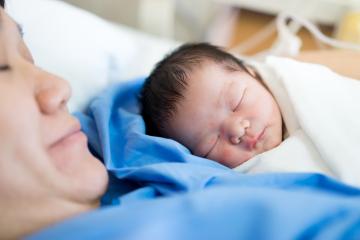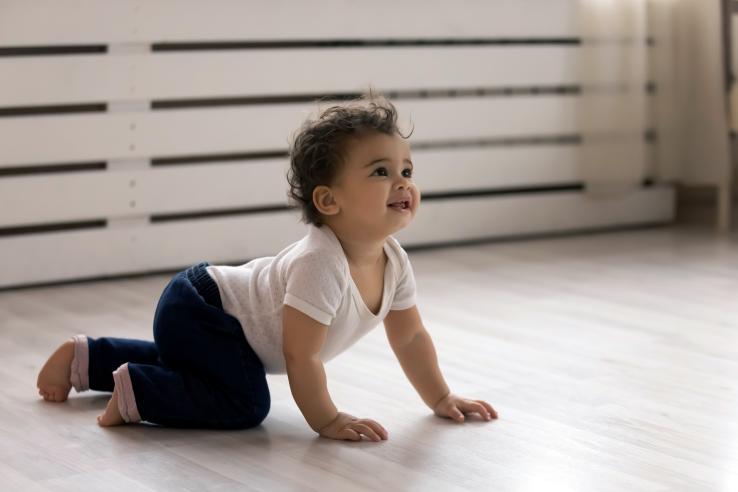
Behind the scenes with researchers from the Baby’s First Years study

Baby’s First Years (BFY), a J-PAL North America-funded study, recently published results showing that monthly cash support impacts infant brain activity. In an interview with J-PAL staff, J-PAL affiliated professor Lisa Gennetian (Duke University) and researcher Kimberly Noble (Teachers College, Columbia University) highlight the collaboration across academic disciplines, discuss policy implications of the early findings, and reflect on results to come.
BFY is the first causal study to examine the relationship between poverty reduction and brain development in young children. What motivated the idea for this research?
Lisa: The seeds for this study came from an observation about both social science and neuroscience literature. Decades of social science research—from randomized controlled trials to clever quasi-experimental designs—point to the negative effects of poverty on children’s development. But this evidence speaks less about the period from birth to age three, which is increasingly recognized as an important time in early development. This is in part because of how hard it is to get objective measures of children’s development during those years.
In the last decade or so, neuroscience literature has shown correlations between children’s early environments—including the socioeconomic status of households—and brain activity. This neuroscience research raises important questions about children’s brain development being adaptive and reactive. However, this research cannot untangle cause from correlation, leaving open the question of how much socioeconomic status of families, and family income in particular, impacts children’s brain functioning.
This study was designed to bridge the gap between these two distinct social science and neuroscience literatures and to address a yet-to-be-answered question about the causal impact of poverty reduction during children’s earliest years of brain development.
The critical component of this study that allows for causal conclusions is randomization. Can you explain how you designed BFY to measure the impact of monthly cash support on early childhood development and what role randomization played in the design?
Kimberly: We’ve known for a long time that children growing up in families that face economic disadvantage, that is often also coupled with financial exclusion and racism, are at risk for a host of negative outcomes. Yet there are many people who would say it’s not poverty: it’s other things associated with poverty, or it’s the choices that families are making. Regardless of where you sit ideologically, from a scientific perspective, the best way to address that question is through a randomized evaluation, or randomized controlled trial. We knew we couldn’t (and wouldn’t) randomize families to economic hardship, but we could offer families with low incomes the opportunity to be randomized into a trial receiving unconditional cash as a means of poverty reduction.
Lisa: We came together as a team over a decade ago with no question that we needed to design a randomized evaluation to answer these questions. The tricky part for our team was not whether we should do it, but how to design it.
Kimberly: The group that we call the “high-cash gift group” receives $333 per month, and the group that we call the “low-cash gift group” receives $20 per month. The amounts were chosen because 1) literature linked a difference in annual income of about $4,000 to positive academic, employment, and health outcomes, and 2) it was an amount that we thought held some policy relevance because it was similar to other social services and benefits that these families were likely to qualify for.
BFY is an interdisciplinary undertaking, involving neuroscience, economics, psychology, and social policy researchers. How has the collaboration between fields affected the research design or execution?
Lisa: Greg Duncan was the champion who pulled this team together—he wanted to bridge neuroscience to social science and invited us to the table. Having a champion with a vision and an extensive network across disciplines is so important to making any multi- and inter-disciplinary research design work.
This collaboration has also been successful because of the hard work of the principal investigators with a shared understanding on the contribution of this study to scholarship about the impacts of poverty, and therefore, evidence to inform policy. We have a high-level theoretical framework that crosses disciplines and has guided the study’s data collection. We’ve always envisioned this research as looking across children’s development. Especially when thinking about the cumulative effects of things like caregiver choices and the child’s home environment—this is not a lens that an economist would necessarily bring to the table, so the interdisciplinary framework is really essential.
What do you see as the policy implications of these early results? How do you hope the findings will contribute to policies that increase family well-being and economic stability?
Lisa: Even though we’ve worked together for over a decade, this study is still in the beginning phase of analyzing data and understanding the findings. No one anticipated there would be something like the expanded child tax credit (CTC) in 2021 (and, to clarify, this study is not an evaluation of the expanded CTC). Having said that, the early results can speak to unconditioned monthly cash, which mimics the expanded CTC in the spirit of cash to families but also mimics child benefits or allowances available in many other countries. Just to note to readers, one key difference between the BFY cash gift and the expanded CTC is that the expanded CTC was available to every child in the household under the age of seventeen, while the BFY cash gift is one monthly amount irrespective of the number of children. There are many other differences related to the design and disbursement of the BFY cash gift too.
The BFY cash gift is a predictable monthly promise to families, no strings attached. In policy circles, I feel we lose sight of stability and predictability. Again, this is where the interdisciplinary perspective of child development is so valuable. This cash gift provides stable income. It doesn’t matter if you got married; it doesn’t matter what assets you’ve accumulated—it’s uncoupled from changing circumstances or eligibility determinations. All of that is stickiness in our existing economic cushion in the US and we have good reasons to believe that this isn’t the best way to think about investments in children.
You note in the paper that these findings come just one year into a multi-year study. What additional outcomes will your team be looking at in the months and years to come?
Lisa: We go back every year to talk to the families at about the time of the focal child’s birthday, and we’ve had excellent retention rates, balanced across high and low cash gift groups and locations. By this summer, we will have four data points: just after birth, age one, age two, and age three. We have information on spending, labor supply, household composition, maternal well-being, the child’s home environment, material hardship, income and benefits, and relationships with partners. We are analyzing that data now. In the next several months, those findings will be out in the public through working papers and peer-reviewed publications.
Kimberly: When we first enrolled moms, it was a three-year study. After we pivoted to phone-based data collection due to the pandemic, our funders generously agreed to extend the cash gift for an additional year, enabling us to push our capstone wave of in-person data collection to the children’s fourth birthdays. This data collection is set to kick off this summer, and we are optimistic that we’ll be able to invite families into our university lab to collect data over the course of twelve months. We will conduct cognitive and behavioral assessments with the kids and measure brain activity again, and hopefully in a much larger sample. We will also measure stress hormones from both moms and kids, mom’s cognitive bandwidth, environmental influences on genes, and other indicators of physical health.
We’re also raising funds to extend the cash gifts an additional two years, which will get us to the child’s sixth birthday—essentially the entire period before the start of formal schooling. Our hope is to follow these kids much longer-term, ideally through adulthood.



